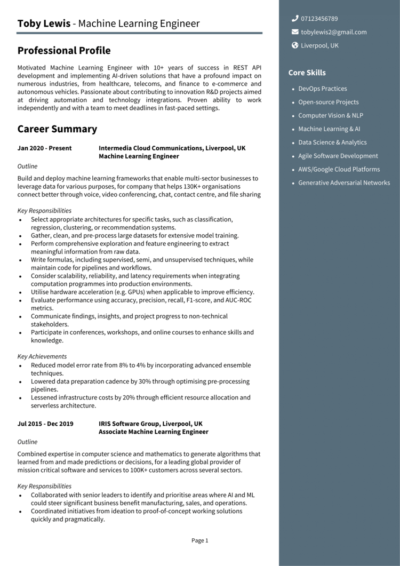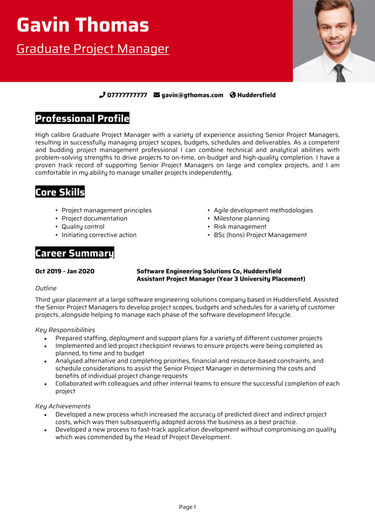You write algorithms that learn from data – but when it comes to job hunting, the learning starts with your CV. Machine Learning Engineer roles are highly technical and increasingly competitive, so you’ll need a CV that showcases more than just Python fluency and model accuracy.
In order to craft a focused CV that highlights your technical expertise, use this step-by-step guide and its Machine Learning Engineer CV example, and you’ll be able to land the rewarding roles you’re after.
Machine Learning Engineer CV
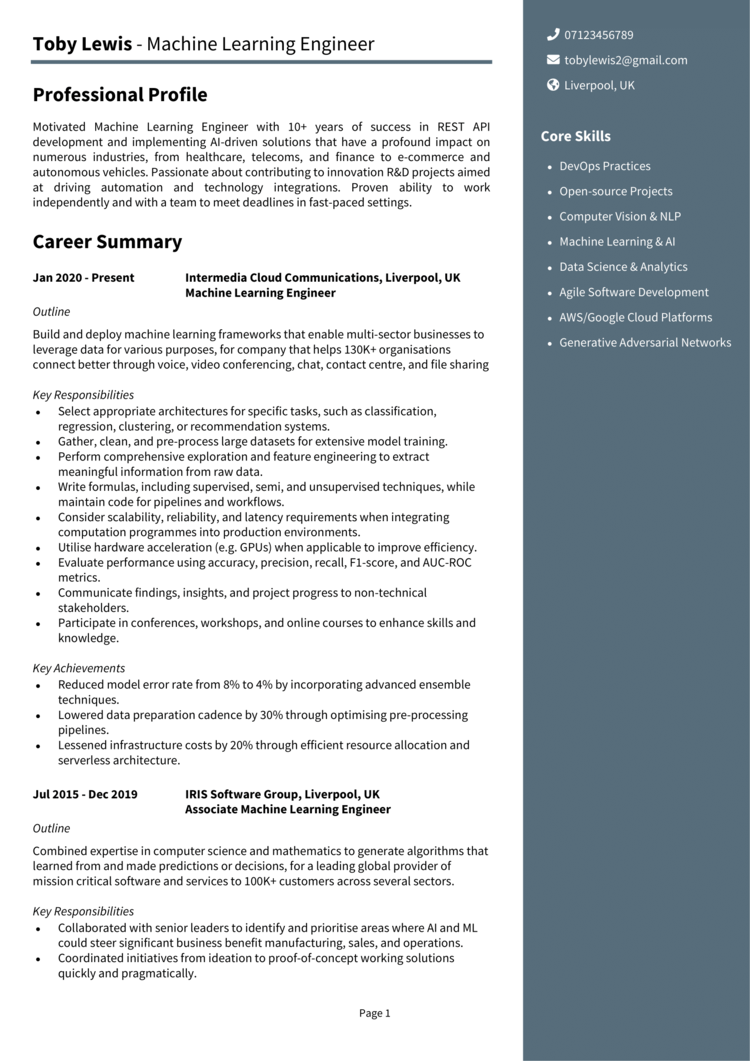
How to write your Machine Learning Engineer CV
Discover how to craft a winning Machine Learning Engineer CV that lands interviews with this simple step-by-step guide.
You know how to make machines recognise cats and predict user churn – now it’s time to make your CV recognise what hiring managers care about.
This guide will walk you through writing a CV, going through the key sections of a strong ML Engineer application: showing you precisely how to convey your value to hiring managers in research teams, startups, or enterprise AI divisions.
The correct structure and formatting for a Machine Learning Engineer CV
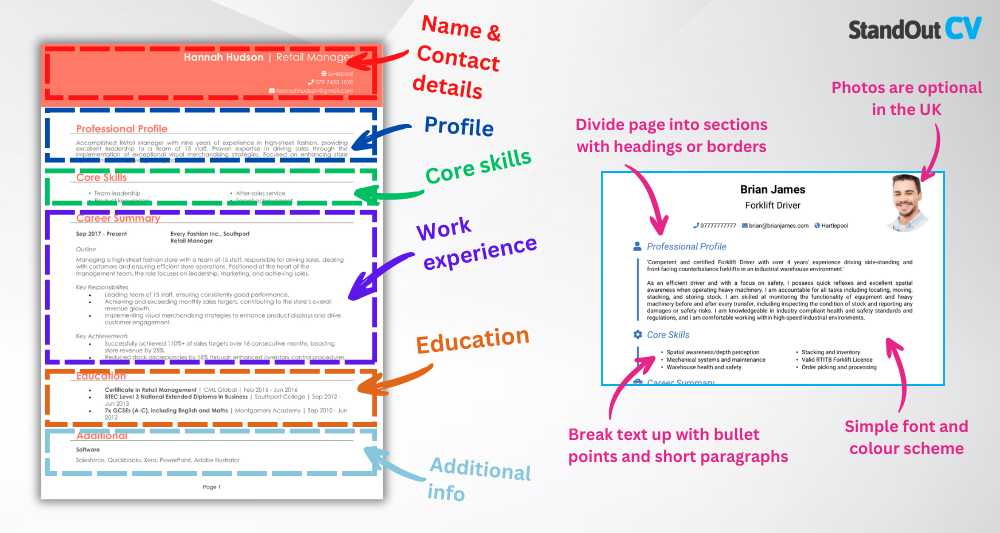
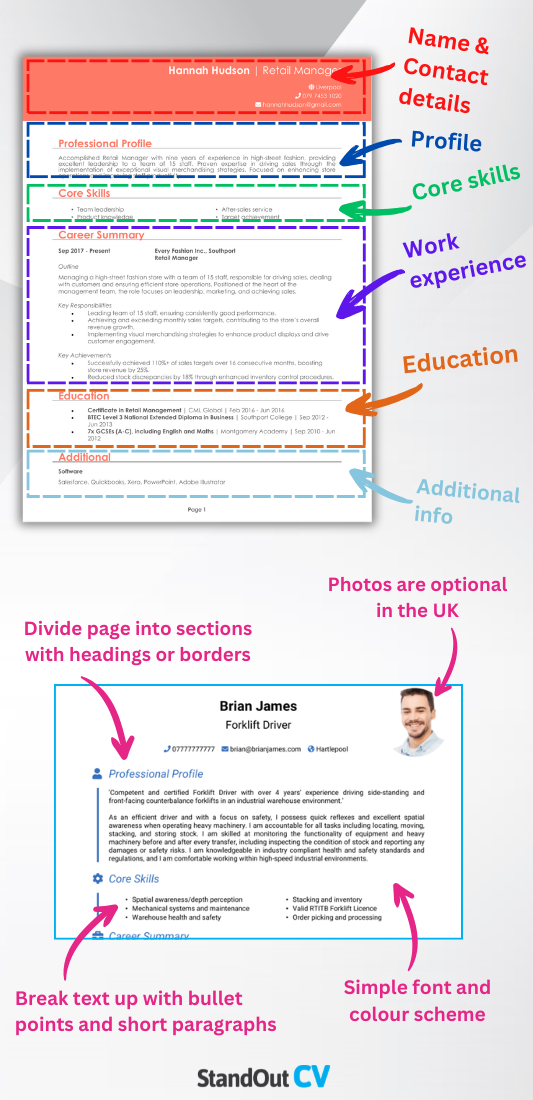
As an engineer, you already understand the importance of clean architecture – and the same applies to your CV. A tidy, well-organised structure shows recruiters you’re methodical and detail-oriented, before your first day on the job. If your CV is the cluttered equivalent of spaghetti code, then recruiters would expect similar mistakes from your work.
Here’s the layout to follow:
- Name and contact details – Display clearly at the top with up-to-date personal details and an optional picture of yourself.
- Profile – Give a short summary of your background, areas of expertise, and career goals.
- Core skills – Use bullet points to highlight key tools and techniques.
- Work experience – Start with your most recent roles and list them in reverse chronological order.
- Education & certifications – Include degrees, ML courses, and relevant credentials.
- Additional info – Optionally add personal projects, open-source contributions, or hobbies, or professional awards.
Use bullet points for responsibilities and achievements, stick to a readable font, and keep your CV to a maximum of two pages in length. Readability and clarity are just as important here as they are in your model pipelines, so don’t give recruiters a hard time trying to find the important parts in your CV format.
CV profile for a Machine Learning Engineer
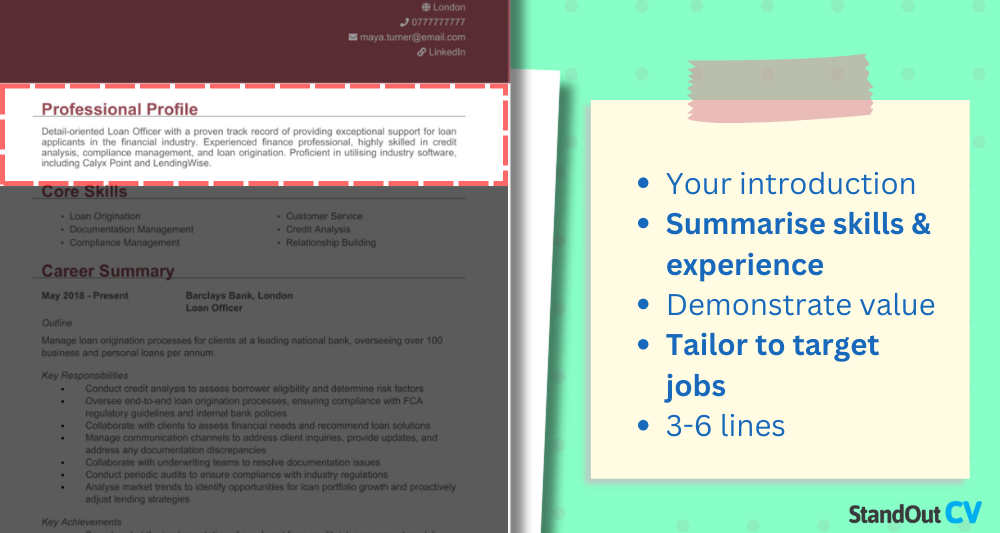
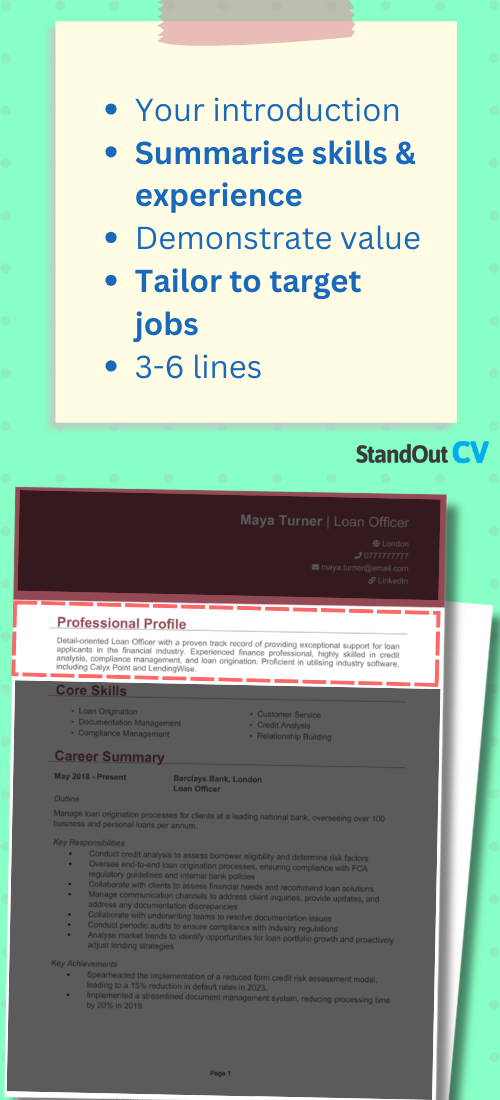
Your CV profile should offer a quick overview of what you do and what you’re great at. It’s your chance to translate technical experience into something meaningful for recruiters and hiring managers, detailing the things which make you the candidate they should want to hire over the competition.
Machine Learning Engineer CV profile examples
Profile 1
Technically proficient Machine Learning Engineer with four years of experience designing and deploying predictive models for fintech and healthcare applications. Skilled in supervised and unsupervised learning, model evaluation, and data preprocessing. Proficient in Python, TensorFlow, and scikit-learn, with hands-on experience in building scalable ML pipelines using cloud platforms like AWS and GCP.
Profile 2
Analytical and solutions-driven Machine Learning Engineer with three years of experience applying machine learning algorithms to solve real-world business problems. Experienced in working with structured and unstructured data, natural language processing, and time series forecasting. Proficient in PyTorch, SQL, and MLflow, with a strong focus on model interpretability and performance optimisation.
Profile 3
Experienced Machine Learning Engineer with five years of experience delivering production-grade machine learning systems across e-commerce and logistics platforms. Skilled in deploying models using Docker and Kubernetes, automating workflows with Airflow, and working in cross-functional agile teams. Passionate about using data-driven solutions to improve decision-making and operational efficiency.
Details to put in your Machine Learning Engineer CV profile
Here’s what to include:
- Where you’ve worked – Note whether you’ve contributed in startups, research labs, enterprise teams, or freelance projects.
- Your top qualifications – Mention degrees (e.g. Computer Science, Data Science, AI) and certifications (e.g. DeepLearning.AI, TensorFlow).
- Essential skills – Refer to your experience with model development, evaluation, and deployment.
- Application domains – Briefly mention fields you’ve worked in, like NLP, CV, recommender systems, or predictive analytics.
- Real-world outcomes – Include how your work improved performance, automation, or decision-making.
How should you write a core skills section?
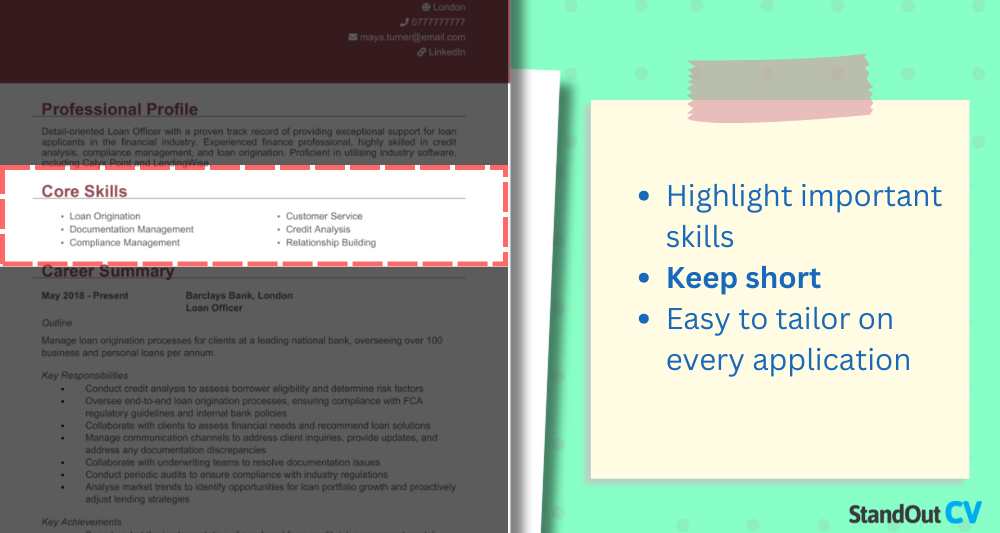

This section gives recruiters a high-level view of your toolbox. Use concise bullet points to highlight the techniques, languages, and platforms you’re confident in – but don’t just list everything you’ve ever touched: keep them focused and tailored.
Focus on what’s relevant to the role, such as frameworks (e.g. PyTorch, TensorFlow), ML methods (e.g. supervised, unsupervised learning), deployment tools (e.g. Docker, Kubernetes), and data handling libraries. Group related skills for your CV together if it helps readability and coherence.
Key skills for a Machine Learning Engineer CV
- Model Development and Training – Designing, building, and training machine learning models using algorithms such as regression, classification, and clustering.
- Data Preprocessing and Feature Engineering – Cleaning, transforming, and selecting relevant data features to improve model performance.
- Deep Learning and Neural Networks – Applying architectures like CNNs, RNNs, and Transformers for complex tasks such as image and language processing.
- Algorithm Selection and Optimisation – Choosing appropriate ML algorithms and fine-tuning hyperparameters to maximise accuracy and efficiency.
- Programming and Scripting – Writing efficient code in Python, R, or Julia using libraries like scikit-learn, TensorFlow, PyTorch, or Keras.
- Model Evaluation and Validation – Assessing models using metrics like precision, recall, F1-score, and cross-validation techniques.
- Data Pipeline Development – Building scalable data pipelines using tools like Apache Airflow, Spark, or Kafka to streamline data processing.
- Deployment and Monitoring – Deploying models into production using APIs or cloud services (AWS, GCP, Azure) and monitoring their real-world performance.
- Version Control and Collaboration – Using Git and collaborative platforms to manage code, experiments, and model iterations.
- Research and Innovation – Staying current with advancements in ML theory and applying cutting-edge techniques to solve real-world problems.
Writing about your work experience
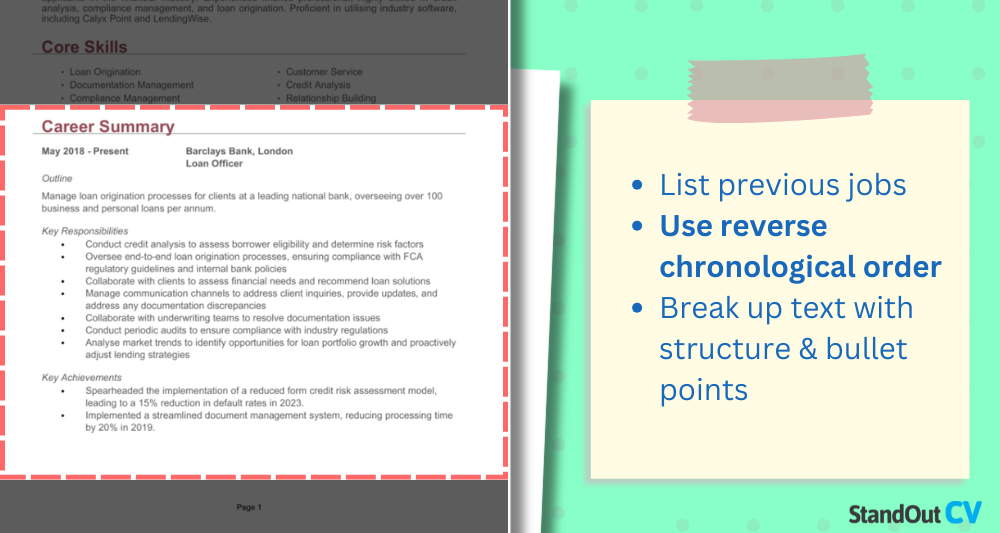
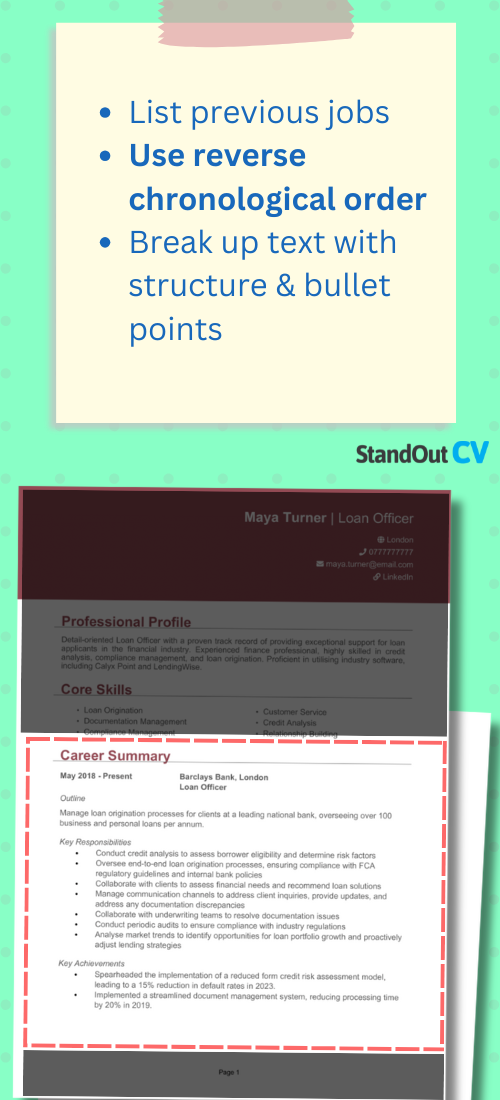
Your work experience section should show how you’ve applied your skills to build and ship models in real-world settings. Employers are interested in what problems you solved, how you solved them, and what impact your work had, and that you’d be able to bring that track record into their firm.
List roles in reverse chronological order, including job title, company, and dates. Use bullet points to outline your responsibilities and achievements. Where possible, mention metrics – like improving accuracy or streamlining training workflows.
Formatting your job history for your CV
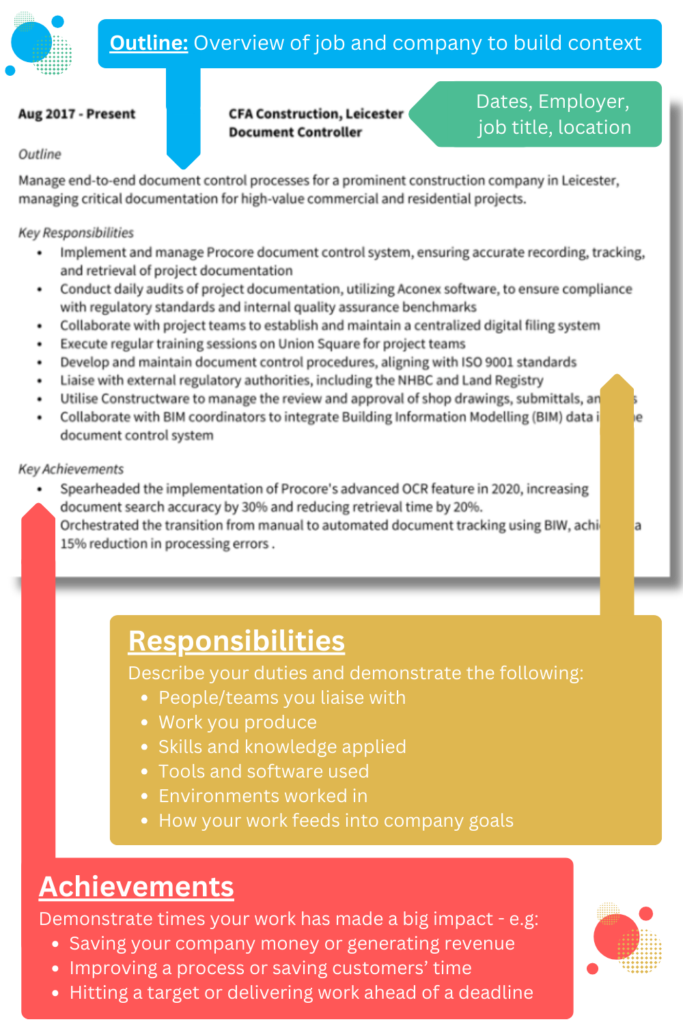
- Outline – Introduce the company or team and your role in the development process.
- Responsibilities – Use action words like “developed,” “trained,” “deployed,” or “automated.”
- Achievements – A great tip is to quantify your impact with real figures: “reduced model training time by 30%,” or “increased prediction accuracy from 78% to 92%.”
Work experience samples for Machine Learning Engineers
Machine Learning Engineer | QuantiSolve AI
Outline
Developed and deployed machine learning models for a fintech startup, enhancing fraud detection and credit risk scoring systems using real-time data streams.
Responsibilities
- Designed end-to-end ML pipelines using Python, scikit-learn, and AWS SageMaker.
- Engineered features and preprocessed data using SQL and pandas for large-scale datasets.
- Collaborated with data engineers and DevOps teams to deploy models into production.
- Used SHAP and LIME to provide model explanations for regulatory reporting.
- Monitored model drift and retrained models based on performance degradation.
Achievements
- Improved fraud detection accuracy by 26% through iterative model development.
- Reduced model training time by 40% by optimising feature pipelines and parallel processing.
- Helped secure £2M in funding by presenting model outcomes and architecture to investors.
Machine Learning Engineer | Infera Health Technologies
Outline
Built ML-driven tools to support diagnostic assistance and patient monitoring in a digital health platform, focusing on image and sensor data.
Responsibilities
- Developed classification and segmentation models using TensorFlow and Keras.
- Cleaned and augmented medical imaging datasets for robust model training.
- Applied CNNs and transfer learning to improve model generalisability.
- Worked with clinicians to define labelling strategies and clinical relevance metrics.
- Integrated models into a mobile health application using ONNX format for edge inference.
Achievements
- Increased diagnostic precision by 18% for early-stage diabetic retinopathy.
- Reduced data labelling time by 30% through semi-supervised learning techniques.
- Presented research at the International Conference on Medical Image Computing.
Machine Learning Engineer | Driftline Logistics
Outline
Designed forecasting models to optimise delivery scheduling and warehouse inventory planning for a logistics and supply chain analytics firm.
Responsibilities
- Built time series models using Prophet, XGBoost, and recurrent neural networks.
- Collaborated with product managers and analysts to define business KPIs.
- Tested model performance with cross-validation and real-time A/B testing.
- Used Airflow to automate data ingestion and model retraining workflows.
- Created dashboards in Tableau to visualise predictions and model confidence intervals.
Achievements
- Reduced delivery delays by 22% by improving demand prediction accuracy.
- Saved £150K in operational costs through improved inventory management strategies.
- Recognised internally for creating a reusable model template used across client projects.
How to write your education section
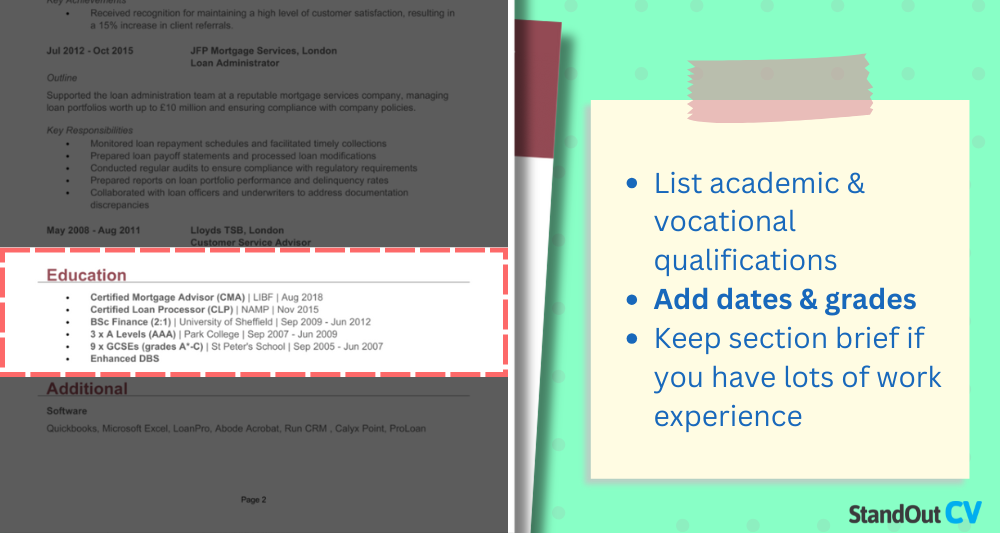

A strong education section and theoretical foundation is essential in ML. Start with your most recent and relevant qualifications – BSc, MSc, or PhD in Computer Science, Engineering, or related fields. Then list certifications or specialisations in deep learning, data science, or cloud platforms.
You can also include online courses from reputable providers (e.g. Coursera, edX) if they add credibility to your portfolio, but make sure to keep this part brief: employers care more about your experience.
Recommended qualifications for Machine Learning Engineers
- BSc or MSc in Computer Science, Machine Learning, or Data Science – Core technical foundation.
- DeepLearning.AI TensorFlow Developer Certificate – Recognised certification for practical ML skills.
- AWS Certified Machine Learning – Specialty – Demonstrates cloud-based ML deployment knowledge.
- Google Cloud Professional Data Engineer – Relevant for ML pipelines and production systems.
- PhD in AI, Computer Vision, or NLP (optional but advantageous) – Particularly for research-heavy roles.


